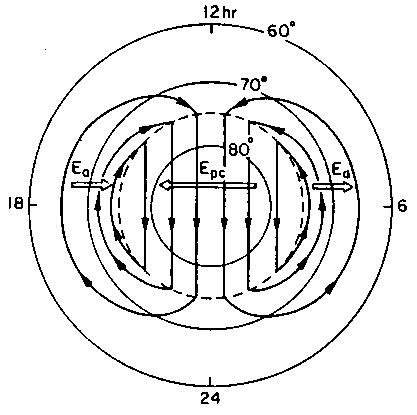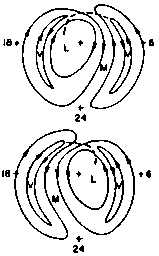 Ionospheric plasma
convection
Ionospheric plasma
convection Ionospheric plasma
convection
Ionospheric plasma
convectionspaceweb@oulu.fi - last update: 26 November 1998, 1440 UT (RR)
Electric field from solar wind/IMF system is mapped (either directly or via magnetosphere) to the high-latitude ionosphere, creating horizontal E × B plasma drift called convection. The actual convection pattern seen depends on the direction of IMF. See also solar wind - magnetosphere - ionosphere coupling.
 In the simplest
case, occurring during southward IMF, the F-region plasma flows antisunward over the polar caps (open field lines, i.e., solar wind regime), and
returns sunward within the auroral oval (closed field lines, i.e.,
magnetospheric regime). This creates the two cell pattern relating to the
convection electrojets in the highly conducting auroral region (see, e.g., Clauer and
Kamide, 1985; also term ionospheric DP 2 or "disturbance polar of the second
type" current system has been used). The two cell pattern is most clear during the substorm growth phase.
In the simplest
case, occurring during southward IMF, the F-region plasma flows antisunward over the polar caps (open field lines, i.e., solar wind regime), and
returns sunward within the auroral oval (closed field lines, i.e.,
magnetospheric regime). This creates the two cell pattern relating to the
convection electrojets in the highly conducting auroral region (see, e.g., Clauer and
Kamide, 1985; also term ionospheric DP 2 or "disturbance polar of the second
type" current system has been used). The two cell pattern is most clear during the substorm growth phase.
In terms of electric fields, we have duskward pointing field over the polar cap, and dawnward field at the auroral latitudes.
 The
situation is more complex during northward IMF: the ionospheric convection is much more
structured, confined to much higher latitudes (polar cap is smaller), and velocities are
of smaller magnitude than in the case of southward IMF. Reconnection is possible only
between the IMF and the open field lines of the magnetotail. This results in four cell or
three cell ionospheric convection pattern for strongly or weakly northward IMF,
repectively.
The
situation is more complex during northward IMF: the ionospheric convection is much more
structured, confined to much higher latitudes (polar cap is smaller), and velocities are
of smaller magnitude than in the case of southward IMF. Reconnection is possible only
between the IMF and the open field lines of the magnetotail. This results in four cell or
three cell ionospheric convection pattern for strongly or weakly northward IMF,
repectively.
It is usually thought that the high latitude cells (that are on open field lines all the time) are due to reconnection, and the low latitude cells are formed due to viscous interaction (Axford and Hines, 1961). In this process the momentum of the magnetosheath plasma is transmitted across the magnetopause by waves and diffusion, creating an effective viscosity. The untisunward convection takes place in closed field lines in equatorial boundary layer. The return flow towards the sun occurs on lower latitude field lines and is driven by back pressure in the magnetosphere near midnight. Observations of just the ionospheric convection signature cannot distinguish between viscous and reconnection based convections, but the measured high cross-polar cap potentials and the dependence of the convection geometry on IMF By suggest that the merging process dominates over viscous interaction when the IMF has a southward component. However, during northward IMF the relative importance of the viscous interaction is larger.
 To be
written. See, e.g., Reiff and Burch (1985).
To be
written. See, e.g., Reiff and Burch (1985).
See also: